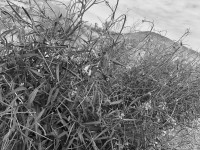Prickly Pear

JULY INGREDIENT: PRICKLY PEAR
It’s the ingredient everyone has been waiting for: prickly pears! If you’re braving out the summer in the high desert, you deserve to treat yourself to a succulent paradise by indulging in this most appropriate mid-summer food. The flat, fleshy pads of prickly pear cacti are called nopales, and make excellent additions to summer staples like smoothies and salsa, and can even be thrown on the grill. The plump oval fruits that grow atop the nopales are called tunas or simply prickly pears, and will ripen into an irresistible magenta as summer wears on. Just a touch sweet, and juicy beyond belief, the pulp from prickly pears can be simmered into a jam, churned with ice cream, pureed into popsicles, or eaten raw. There’s no shortage of possibilities when it comes to this easy-to-identify plant that’s also conveniently sold in many local grocery stores.
If you plan to harvest your own, make sure you take all the necessary precautions to prevent injury (mostly just time-consuming irritation) from the microscopic hairs, or glochids, that grow on the tunas and have a knack for lodging themselves in human skin. For information on collecting and safely processing prickly pears and nopales, check out desert harvesters’ suggestions: http://www.desertharvesters.org/native-plant-food-guides-the-desert-can-feed-you/prickly-pear/
There’s no wrong way to do it, and no shortage of tricks people have shared in books and on the web! —Sarah Witt
For more information on HDTK, as well as helpful tips on where prickly pear grows and it’s many uses, check out Sarah’s website.
Monday, July 17th at 7pm
Copper Mountain Mesa Community Center
65336 Winters Road, Joshua Tree, CA
From September 2016 to July 2018 Sarah Witt organized High Desert Test Kitchen (HDTK), a monthly dinner gathering at the Copper Mountain Mesa Community Center in North Joshua Tree. Each month a different ingredient was featured with the challenge of incorporating local desert roots, fruits, insects, or a handful of twigs into a culinary repertoire. Participants would bring a dish to share, gathering together to discuss where the ingredients were sourced, the manner in which they were processed, and to consider their EQ (or edibility quotient). To read more about these native ingredients visit Sarah’s website.


















